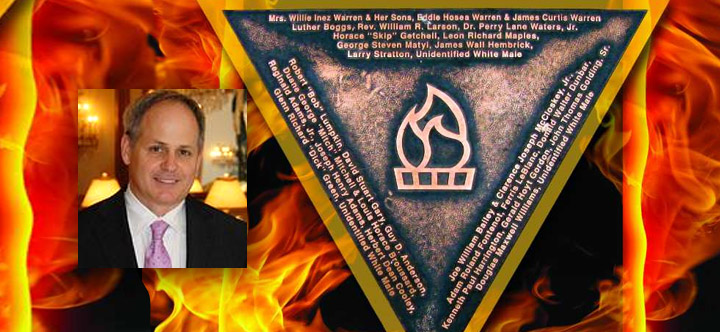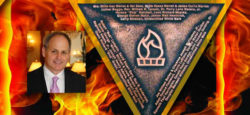Q&A: Clayton Delery-Edwards
Delery wrote The Up Stairs Lounge Arson: Thirty-Two Deaths in a Gay Bar, June 24, 1973, the story behind the most fatal blaze in New Orleans’ history, a deliberately ignited fire that targeted a gay bar in the French Quarter.
Published: March 22, 2015
Last Updated: August 19, 2021

When did you first become familiar with the Up Stairs Lounge fire, and what led you to write the book?
In June of 1973 I was fifteen years old and living in Metairie, a suburb of New Orleans. I had always sensed that I was different from other boys—and even if I hadn’t, they were more than willing to tell me. I was just beginning to acknowledge that the difference might be sexual or affectional in nature. There were no “out” gay celebrities or public figures at that time, nor even any out gay men or women among my family or friends, so I had no one to look toward or who to ask about what being gay might mean for my future. I was watching television one night, and the regular programming was interrupted with news of a fire in a French Quarter bar. Even the earliest news reports included the details that it was a bar frequented by homosexuals, and that there were suspicions of arson. And I remember thinking, “Oh, my God! They’re going to kill me!”
During that summer I rode my bicycle from Metairie to the French Quarter and found the former location of the Up Stairs Lounge. The building was readily identifiable by the boarded windows and smoke-stained walls. I often went past it in the coming years, wondering about any survivors, and saying prayers for the dead.
For a long time The Up Stairs Lounge receded into my consciousness, but it never went away. I rarely saw or heard references to it until 2003, when I read a story in The Times Picayune about a memorial plaque being placed in the sidewalk outside the former entrance of the Up Stairs. I realized then that other people did remember it, and that there might be an audience for a book.
Life has a way of getting in the way of intentions—we all know about the road to Hell—but from time to time I would talk about my idea for a book until, one day in 2009, my husband said, “Would you just shut up and write the damn thing?” I started research the next day, and five years later, almost to the day, it was published.
One of my reviewers commented that the book is particularly valuable for younger generations of readers—both gay and straight—who will be shocked to learn how harsh life was for gays and lesbians 40 years ago. That was part of my intent, so I hope it’s true.
Why was no arrest made even though the police identified a lone suspect?
Investigators for both the New Orleans Police Department and the arson investigation unit of the state fire marshal’s office soon identified the same man as the principal subject of their investigations. He had been in the bar and had engaged in disruptive behavior, which culminated in him getting into a fight. Because he was seen as the aggressor, he was thrown out of the bar. Witnesses later said that, before he left, he issued threats.
The Up Stairs Lounge, as the name suggests, was on the second floor of the building, and it was accessed by a long, narrow stairwell entered from a door on Iberville Street. About an hour after this man was thrown out, somebody emptied a small can of cigarette lighter fluid on the bottom stairs and ignited it. The stairwell acted as a chimney flue, funneling flame, smoke, and flammable gasses inside the lounge, killing 29 people at the site, and sending fifteen to the hospital, where three more later died.
The empty lighter fluid can was found at the bottom of the stairwell, and a man who fit the description of the suspect had purchased such a can that day at the Walgreen’s one block away. But there were several pieces missing that made arrest difficult, if not impossible: there were no fingerprints on the can; nobody came forward to say they saw who poured the lighter fluid on the stairs; the clerk who sold the lighter fluid was unable to pick the suspect out of a photo line-up. If any of these pieces of evidence had been in place, the suspect might well have been arrested and gone to trial.
While I will concede that the evidence was circumstantial, I think investigators made some clear blunders, and I am also of the opinion that the police called off the investigation in a curious way, and at a very curious time. Their case report left me highly unsatisfied, and with many unanswered questions.
What did you learn about public response to the Up Stairs Lounge fire?
One of the most remarkable things about the fire was the degree of homophobia it revealed in New Orleans. Major Henry Morris of the NOPD described the Up Stairs to journalists as a hangout for “thieves and queers,” certainly disparaging the victims, and by extension blaming them for their own deaths. A local radio personality said on the air that the best way to dispose of the dead gay people was to “bury them in fruit jars.” Many civic and religious leaders, who had been quite vocal in their expressions of sympathy for the victims of other recent fires, maintained a conspicuous and stony silence about the victims in the Up Stairs Lounge. Their silence sent the message that these dead and suffering people were negligible, dispensable, and perhaps even deserving of their fate.
However, some local Protestant clergy did hold memorial services—even in the face of fierce criticism. Services also took place in several other major cities, and hundreds of people throughout the United States sent donations to help give financial assistance to the suffering and to help defray the costs of burial for the dead.
Most of these donations came from gays and lesbians, and the fire prompted a degree of social and political organization among them at the national level that had not previously existed. This is one of the very important legacies of the fire.
Did you have difficulty getting survivors to speak with you?
At first I had a difficult time finding survivors whom I could interview. The people in the bar that night were almost entirely gay men. If they survived the fire in 1973, and survived AIDS in the 1980s and 1990s, by the time the 21st century arrived, many of them were dying of strokes, heart attacks, cancer, and the other various ills that take people in their sixties, seventies, and eighties. The first survivors I found were reluctant to speak to me because the fire had been such a traumatic experience that they did not want to relive it one more time. Two different men I was able to interview told me later that talking about the fire again had caused them to have horrible recurring nightmares.
They weren’t all like that, however. Francis Dufrene, whose injuries from the fire sent him to the hospital for several weeks, looks back on the bar very fondly, and had no hesitation at all about telling me what he experienced that night. When I told him about the pain some people were still experiencing, he seemed genuinely surprised. “Really?” he asked. “They’re still having nightmares after all these years? They should be talking about what happened. It’s like therapy!”
Those who had not been in the fire itself were more willing to speak. I was able to interview people—responders or bystanders—who had witnessed the events from the street, and I was able to speak to former patrons who had not been in the bar that night, or who had been fortunate enough to leave before the fire started. I also found a treasure trove of information in various archives where the case reports of the New Orleans Police Department and the investigators for the fire marshal are on file. These records include verbatim statements given by dozens of survivors and witnesses whose stories, recorded shortly after the fire in 1973, provide a vivid picture of what took place.
Some have called the Up Stairs Lounge Fire the “Stonewall of New Orleans,” referring to a riot at a gay bar in New York City in 1969 that many believe launched the gay rights movement. Do you think that is true?
There are people who call the fire at the Up Stairs Lounge the New Orleans equivalent of the Stonewall riots that took place four years earlier, and who claim that the fire was responsible for the start of sustained progress in gay rights in New Orleans. There are others who claim that the fire had no permanent effect whatsoever, and that there were no sustained or appreciable advances until four years later, when Anita Bryant visited the city shortly after pushing through an anti-gay ballot initiative in Dade County, Florida. Her visit to the city provoked a demonstration involving thousands of gays and lesbians, and many say that the Bryant controversy, rather than the Up Stairs, is when progress began to occur.
I’m going to split the baby and say that both are right and both are wrong. Sustained gay activism among the LGBT community in New Orleans really did not take hold until after 1977. However, the Up Stairs fire resulted in definite policy shifts in municipal government, and also resulted in a shift in the way some media outlets—principally The Times Picayune—treated LGBT issues. Before the fire, both City Hall and the local news outlets basically had a “Don’t Ask, Don’t Tell” attitude toward gays and lesbians. After the fire, that was no longer possible. And I believe I show that those shifts helped everyone advance as we moved forward.
What was the most surprising thing you learned?
The most surprising thing was what the culture of the Up Stairs Lounge had been like. As I said, I was 15 at the time of the fire, so of course I had never been there, but I assumed that, like a lot of other French Quarter bars, it was basically a place to go and get drunk and maybe—if you were lucky—you’d go home with somebody at the end of the night.
But it was really much more like a social club or a community center. The Up Stairs hosted religious services for gay people. It hosted charity benefits. They had special parties and held theatrical performances in a back room they had turned into a theater. Like the bar in the television series Cheers, it really does seem to have been a place where everyone knew your name, or, if they didn’t, they’d at least call you “honey” or “sweetheart.” All of the former patrons speak of the Up Stairs as being very different from most French Quarter bars—gay and straight alike. I don’t know of any place currently operating that’s like that.
